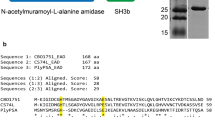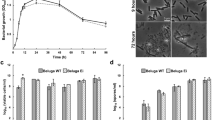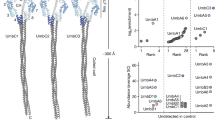Abstract
It is generally accepted1 that in Clostridium botulinum both growth and toxin formation are completely inhibited at pH values below 4.6. This critical pH value has been confirmed by many investigators using food as substrate2–5 or culture media3,6–8. Occasionally9–12 growth of C. botulinum and toxin formation at pH values lower than 4.6 have been reported. In these cases the authors ascribed the unexpected outgrowth and toxin formation to local pH differences in inhomogeneous media and growth of C. botulinum before pH equilibration, or to the fact that fungi created microenvironments within or adjacent to the mycelial mat, where the pH was higher than 4.6 as was demonstrated by Odlaug and Pflug11,12. We show here that the general assumption that C. botulinum does not grow below pH 4.6 is incorrect. We have observed that growth and toxin formation by C. botulinum can take place in homogeneous protein rich substrates (containing 3% or more soya or milk protein) at pH values lower than 4.6.
This is a preview of subscription content, access via your institution
Access options
Subscribe to this journal
Receive 51 print issues and online access
$199.00 per year
only $3.90 per issue
Buy this article
- Purchase on Springer Link
- Instant access to full article PDF
Prices may be subject to local taxes which are calculated during checkout
Similar content being viewed by others
References
Edwards, C. C. Fedl Register 38, 2398–2410 (1973).
Ingram, M. & Robinson, R. H. M. Proc. Soc. appl. Bact. 14, 73–84 (1951).
Townsend, C. T., Yee, L. & Merce, W. A. Food Res. 19, 536–542 (1954).
Hauschild, A. H. W., Aris, B. J. & Hilsheimer, R. Can. Inst. Food. Sci. Techn. 8, 84–87 (1975).
Huhtanen, C. N., Naghaki, J., Custer, C. S. & Russel, R. W. Appl. envir. Microbiol. 32, 711–715 (1976).
Dozier, C. C. J. infect. Dis. 35, 105–133 (1924).
Baird-Parker, A. C. & Freame, B. J. appl. Bact. 30, 420–429 (1967).
Ohye, D. F. & Christian, J. B. H. in Botulism 1966 (eds Ingram, M. & Roberts, T. A.) 217–233 (Chapman and Hall, London, 1967).
Amato de Lagarde, E. & Beerens, H. Ann. Inst. Past. Lille 21, 231–254 (1970).
Nikolaeva, S. A. & Mazokhin, N. N. Vop. Pitan 30, 83–86 (1972).
Odlaug, T. E. & Pflug, I. J. J. Food Protect. 41, 566–573 (1978).
Odlaug, T. E. & Pflug, I. J. Appl. envir. Microbiol. 37, 496–504 (1979).
Author information
Authors and Affiliations
Rights and permissions
About this article
Cite this article
Raatjes, G., Smelt, J. Clostridium botulinum can grow and form toxin at pH values lower than 4.6. Nature 281, 398–399 (1979). https://doi.org/10.1038/281398a0
Received:
Accepted:
Published:
Issue Date:
DOI: https://doi.org/10.1038/281398a0
Comments
By submitting a comment you agree to abide by our Terms and Community Guidelines. If you find something abusive or that does not comply with our terms or guidelines please flag it as inappropriate.



